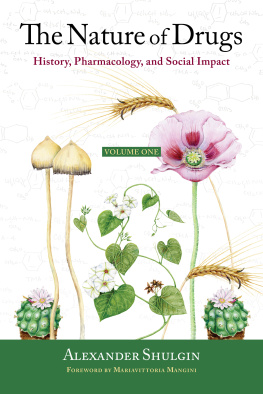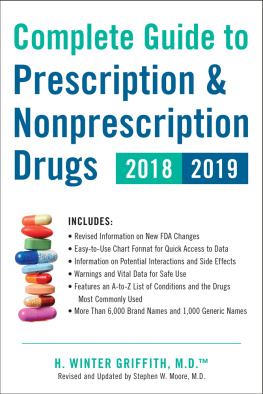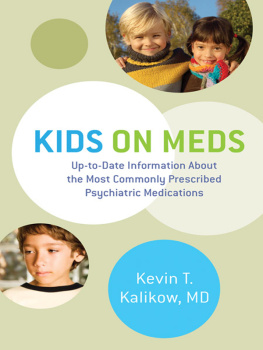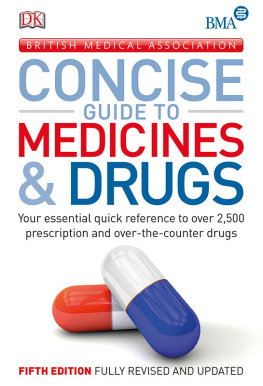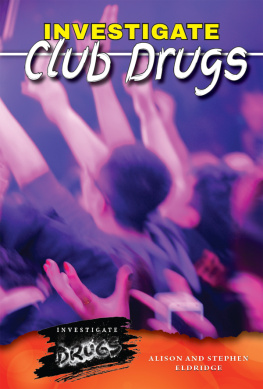Pills, Potions and Poisons
Pills, Potions and
Poisons
How drugs work
TREVOR STONE
Professor of Pharmocology, University of Glasgow
and
GAIL DARLINGTON
Consultant Physician and Rheumatologist, Epsom General Hospital





Dedicated affectionately to Tom and Alice and to Norman, Debbie and Kelvin
Foreword
Richard Wilson
Many of us read with horror the list of side-effects of drugs that comes with a bottle of pills. Even so it is astonishing to realise that up to half of all the drugs prescribed by doctors are not taken according to the instructions, when the disease being treated-even a common one like blood pressure-is far more dangerous than the drugs. Of course, most people do not relish the idea of spending the rest of their lives depending on drugs, but this state of affairs represents an enormous waste of research and health workers' time and resources. Perhaps if people understood more about their medicines and how they are working to help them, there would be less waste and, overall, better health.
I met Professor Stone when I was Rector of Glasgow University (he is Professor of Pharmacology there) and, along with Gail Darlington, a consultant physician, they have cut through the medical and scientific jargon to present us with a summary of how drugs work in a language most of us non-scientists can understand. At the same time, they have liberally sprinkled the text with anecdotes and quotations, sometimes historical, sometimes humorous and always providing fascinating insights into the people and human stories behind the discovery of drugs which we take for granted. I was fascinated to read whilst looking through ALCOHOL (I wonder why I was attracted to that section) that chemicals contained in it can interact with chemicals in the brain, like dopamine, to produce molecules which closely resemble morphine and its related drug heroin. Perhaps there is not such a difference between hard and soft drugs then! The book makes a fascinating entertaining read. I am sure this book will find its rightful place among the growing number of books which contribute to the Public Understanding of Science.


Preface
Normally we are almost unaware of the complexity of the human body. We take so much for granted about our bodies because they have evolved to a state in which a million different chemical reactions, some involving hormones, transmitters, receptors, and enzymes all function in a co-ordinated fashion, needing little or no deliberate help from us. Yet each component of our bodies is a marvellous and intricate machine, and it is only when something goes wrong that most of us become aware of our organs and tissues, and begin to seek information about how and why things work as they do.
The purpose of this book is to provide a basic understanding of drugs and how they work. It is written in an attempt to remove the mystery and, for some people, the fear, which surrounds the use of conventional medicines. It is hoped that it will be useful to a wide range of readers, whether or not they have any medical knowledge, and it has been written to provide a book which is both readable and enjoyable in its own right, and one which provides a source of facts and information about particular drugs when this is needed.
The book is neither a medical textbook nor a layman's guide to medicine and diagnosis, but explains some of the basic processes underlying diseases and the ways in which medicines act to combat those processes. Understandably, patients object to being expected to take, often without adequate explanation, the wide variety of pills, tablets, capsules, suppositories, ointments, and injections which their doctors prescribe. As a result, many patients worry about their drugs, particularly if they experience mild side-effects, and may stop a course of treatment far too early to produce the maximum benefit. Often the patient does not confess this to the doctor in case he or she might feel that the patient lacks confidence in them.
Ideally, doctors should always explain the medicines they prescribe, and patients should ask the questions that worry them about their treatment. How are these medicines working? Are they curing the disease or merely masking the symptoms? How are they reducing the symptoms of disease? What are the main side-effects to be expected and what causes them? Although it is not intended as a comprehensive guide to all the side-effects of drugs, the book does discuss the major ones and explains, where known, the reasons why those effects occur.
We have included most of the more common disorders for which useful drugs are available. In addition, chapters are included on conditions such as Alzheimer's disease for which few drugs have been available but for which the pharmaceutical industry is now able to offer hope since drugs are being developed which promise the possibility of real benefit to patients.
In addition we have taken a look at some of drugs which are now widely used, not for the treatment of disease, but for recreation: drugs such as alcohol, nicotine, ecstasy, and marijuana. We also consider a few of the 'poisons' which may affect people on occasion, from bee stings to sheep dip, and glance at the enormous range of poisons found naturally in the plant and animal kingdoms. Finally, we have examined briefly the enormous complexity, costs, and ethical issues involved in drug development in the pharmaceutical industry, including the use of animals for medical research, the incidence of side-effects, and the issue of patient choice.
Although the book is intended primarily to explain the actions of the many drugs now used by doctors, a science called `pharmacology, we have along the way provided a generous helping of `physiology, the science of how the normal body works. We have included a glossary to help with terms which may be unfamiliar to some readers.
Acknowledgements
We are grateful to many people who have helped in the preparation of this book. Several colleagues and patients have kindly provided illustrations, or given permission for the use of illustrations including Professor Tony Payne (University of Glasgow), Professor Robert Anderson (National Heart and Lung Institute), Dr Chris George and Dr Louis Temple (Epsom General Hospital), Dr Dilip Murthy (International Centre for Health Sciences, Manipal), Mr and Mrs Thorp and the staff of the Wellcome Photographic Library.


